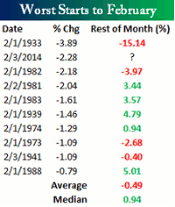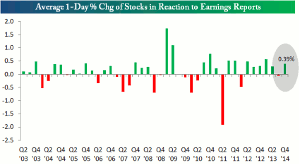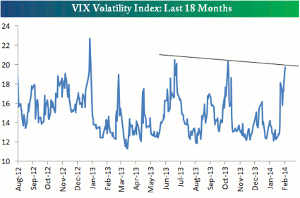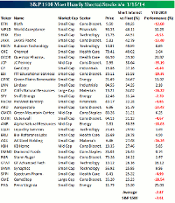As the stock market continues to exhibit choppiness, the staff at bespokeinvest.com details the statistics that tell the tale of the tape.
The S&P 500 (SPX) (SPY) followed up a horrible January with a horrible start to February. In fact, Monday's decline of 2.28% for the S&P 500 was its second worst start to February (first trading day) ever going back to 1928! As shown below, the only other year where February got off to a worse start was in 1933 when the index fell 3.89%. In that year, the index declined another 15.14% for the remainder of the month! Let's hope the same isn't in store this February, that's for sure.
Looking at the ten worst starts to February in history, the S&P has actually risen for the remainder of the month more than it has fallen, but as shown in the table, the two worst starts (which this year now sits in between) both saw declines over the rest of the month. Maybe we're lucky February is only 28 days.
Don't Blame Earnings
The S&P 500 has experienced a significant pullback of more than 5% since earnings season began on January 9. Amazingly, though, the average stock that has reported so far this season has gained 0.39% on its report day. (For companies that report in the morning, we use that day's change. For companies that report after the close, we use the next day's change.)
When the market falls this much during earnings season, the average one-day change for stocks that have reported is usually very negative. But this season companies have averaged gains when they have reported, even as the rest of the market has plummeted. This tells us that on a micro level investors have been pleasantly surprised by what they are hearing from individual companies. Unfortunately, macro factors have been outweighing the good micro news and investors are just unwilling to own stocks in general right now. Earnings are the ultimate driver of stocks, and in our view, the fact that stocks are going up on their report days this season is a good sign for the long-term health of this market.
VIX at Upper End of Range
The CBOE Volatility Index (VIX) (VXX) has spiked 62% over the last few weeks and is now back around 20. Looking at the chart over the last 18 months shows that it is now right at levels where it has peaked out during prior market pullbacks in recent history. This tells us that the market is now at a key pivot point. A bounce would cause bulls to breathe a sigh of relief. A break higher in the VIX from here likely means we're in store for a continued move lower that we haven't experienced in quite a while.
S&P 1500 Most Heavily Shorted Stocks & Sectors
Short interest levels for the middle of January were released last week, and in the table below we have summarized the 30 stocks in the S&P 1500 that have the highest short interest as a percentage of float. As is usually the case, the list below is dominated by small-cap stocks. Of the 30 names listed, 24 (80%) are in the S&P 600 Small-Cap Index. Of the remaining six names, four are mid caps (S&P 400) and just two—Cliffs Natural (CLF) and Gamestop (GME)—are large-cap S&P 500 stocks. The sector breakdown of the list is also right in line with what is typical. Nearly one-third (nine) of the stocks on the list are Consumer Discretionary (XLY), while Technology (XLK) is the next closest on the list with five stocks. The only two sectors with no stocks on the list are Telecom Services (XTL) and Utilities (XLU).
With equities off to a terrible start in 2014, one would think that short sellers would be dancing in the streets. If the performance of the most heavily shorted stocks is any indication, however, short sellers haven't been doing that great. As shown in the right hand side of the table, while the S&P 1500 is down 3.61% so far this year, the most heavily shorted stocks in the S&P 1500 have actually outperformed the index with a decline of 2.67%. Whether the market has been up or down in the last few months, short sellers haven't been able to catch a break.
By the Staff of bespokeinvest.com

























